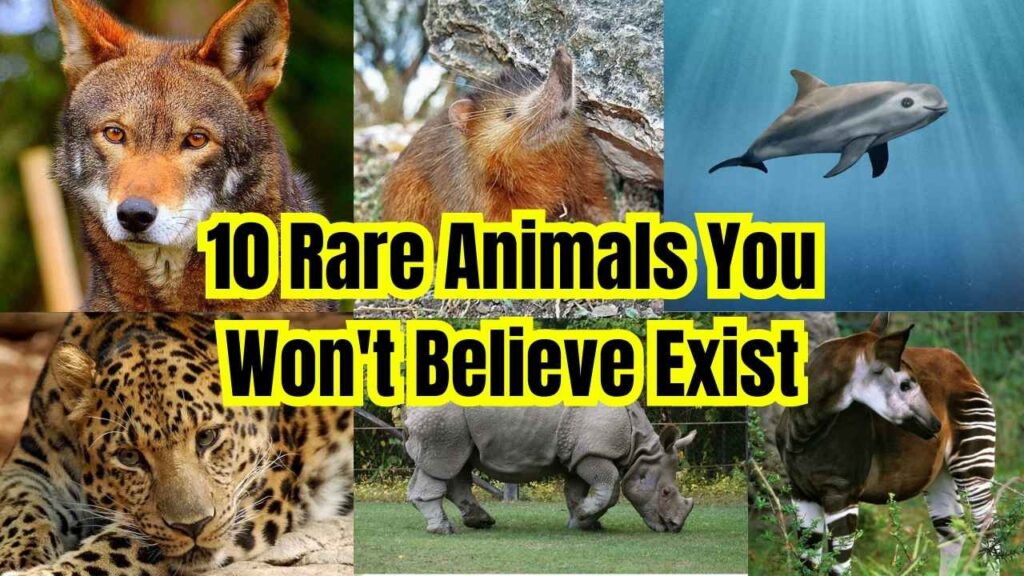
The world is full of extraordinary creatures, but some are so rare that few people even know they exist. These animals are often critically endangered, with only a handful remaining in the wild. Learning about them is crucial for raising awareness and protecting these unique species from extinction.
Top 10 Rarest Animals in the World
| Rare Animal | Estimated Population | Key Threats | Conservation Status |
|---|---|---|---|
| Saola | < 100 | Habitat loss, poaching | Critically Endangered |
| Vaquita | < 10 | Bycatch in illegal fishing | Critically Endangered |
| Amur Leopard | ~84 | Habitat destruction | Critically Endangered |
| Javan Rhino | ~74 | Poaching, habitat loss | Critically Endangered |
| Northern Hairy-Nosed Wombat | ~315 | Habitat loss | Critically Endangered |
| Cuban Solenodon | Unknown | Habitat loss, predators | Endangered |
| Devils Hole Pupfish | ~263 | Habitat degradation | Critically Endangered |
| Kakapo | ~252 | Disease, predators | Critically Endangered |
| Red Wolf | ~20 | Habitat loss, human conflict | Critically Endangered |
| Angel Shark | Unknown | Overfishing, habitat loss | Critically Endangered |
The world’s rarest animals are facing immense threats, but conservation efforts provide hope for their survival. By raising awareness and supporting conservation initiatives, we can help protect these extraordinary creatures for generations to come.
1. Saola (Pseudoryx nghetinhensis)
Nicknamed the “Asian unicorn,” the Saola was discovered in 1992 in the Annamite Mountains along the Laos-Vietnam border. With fewer than 100 individuals estimated to exist, this elusive forest-dweller faces threats from habitat destruction and poaching. Conservation programs aim to protect its habitat and track remaining populations.
2. Vaquita (Phocoena sinus)
The Vaquita, a small porpoise native to the Gulf of California, is the most endangered marine mammal. Fewer than 10 individuals remain, largely due to accidental entanglement in illegal fishing nets. Conservation groups are working to remove these harmful nets and promote sustainable fishing practices. Learn more about Vaquita conservation.
3. Amur Leopard (Panthera pardus orientalis)
With fewer than 84 individuals in the wild, the Amur leopard is one of the rarest big cats. Found in Russia and parts of China, this species is threatened by poaching and habitat destruction. Conservation parks and breeding programs are helping increase its population.
4. Javan Rhino (Rhinoceros sondaicus)
The Javan rhino exists only in Ujung Kulon National Park, Indonesia. With just 74 individuals, this species is heavily protected by conservationists. Strict monitoring and habitat restoration are key to ensuring its survival.
5. Northern Hairy-Nosed Wombat (Lasiorhinus krefftii)
Native to Australia, the Northern Hairy-Nosed Wombat was once thought to be extinct. Recent conservation efforts have raised its population to 315 individuals. Protected reserves and breeding programs continue to aid this species.
6. Cuban Solenodon (Atopogale cubana)
This elusive, venomous mammal is native to Cuba. With its population numbers unclear, the Cuban Solenodon faces threats from habitat destruction and introduced predators. Rediscovered in 2003, researchers are working to study and protect this unique species.
7. Devils Hole Pupfish (Cyprinodon diabolis)
Found only in a single water-filled cavern in Nevada, the Devils Hole Pupfish is critically endangered with an estimated 263 individuals. Conservationists monitor this delicate ecosystem closely to maintain the species’ habitat.
8. Kakapo (Strigops habroptilus)
The flightless, nocturnal Kakapo from New Zealand has seen its population increase to 252 individuals through intensive conservation. Efforts include hand-rearing chicks and protecting habitats from predators.
9. Red Wolf (Canis rufus)
Once declared extinct in the wild, the Red Wolf has fewer than 20 individuals remaining in North Carolina. Conservation programs continue to reintroduce these wolves to protected areas.
10. Angel Shark (Squatina squatina)
The Angel Shark‘s flat body and wing-like fins make it distinct. Due to overfishing, this species’ population is dwindling in the northeastern Atlantic and Mediterranean. Marine protected areas are key to its conservation.
How Can You Help Protect These Animals?
- Support Conservation Organizations: Groups like the World Wildlife Fund (WWF) and International Union for Conservation of Nature (IUCN) work directly to protect these animals.
- Adopt a Rare Animal: Many organizations offer symbolic adoptions that fund conservation programs.
- Reduce Wildlife Trade Support: Avoid purchasing exotic animal products or souvenirs.
- Spread Awareness: Sharing knowledge about these rare animals can inspire others to join conservation efforts.
Frequently Asked Questions (FAQs)
Q1: Which animal is considered the rarest in the world?
A: The Vaquita is considered the rarest, with fewer than 10 individuals remaining in the wild.
Q2: Why are these animals so rare?
A: Factors such as habitat destruction, poaching, and human activity significantly contribute to population decline.
Q3: Are there active efforts to protect these animals?
A: Yes, numerous conservation programs focus on habitat restoration, breeding programs, and monitoring.
Q4: How can I contribute to conservation efforts?
A: Donating to reputable organizations, volunteering, or spreading awareness are great ways to help.










